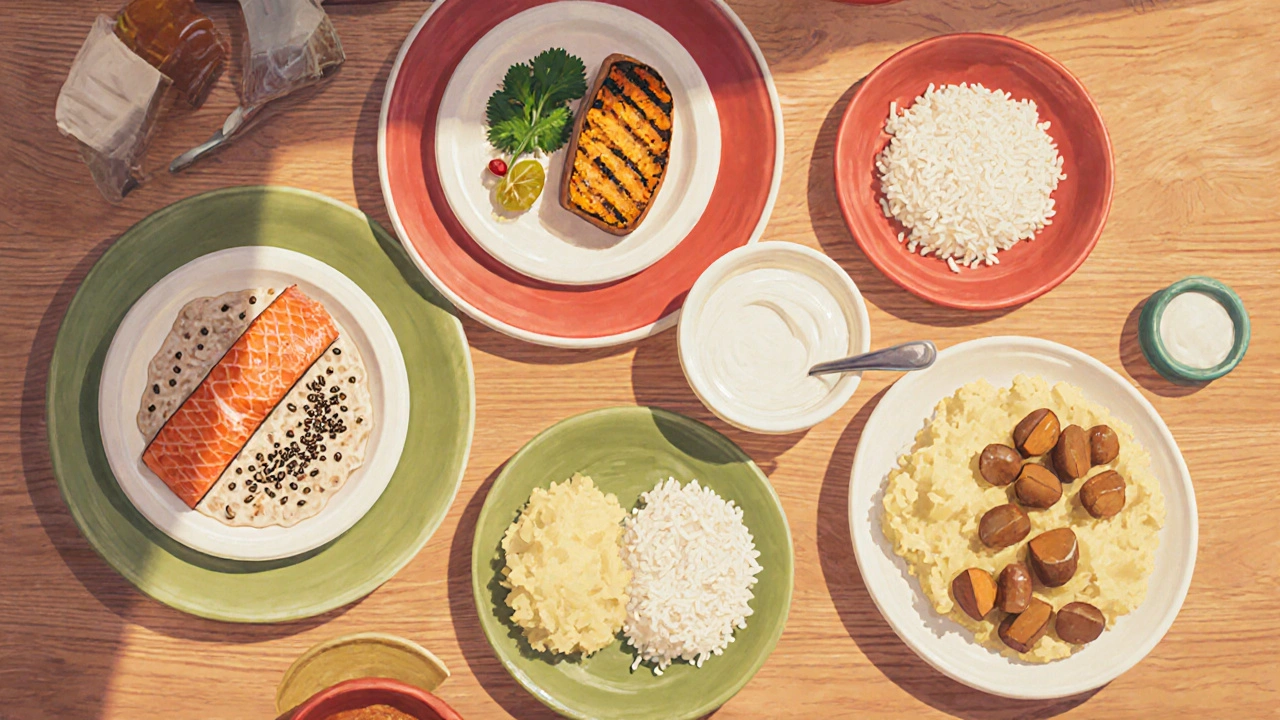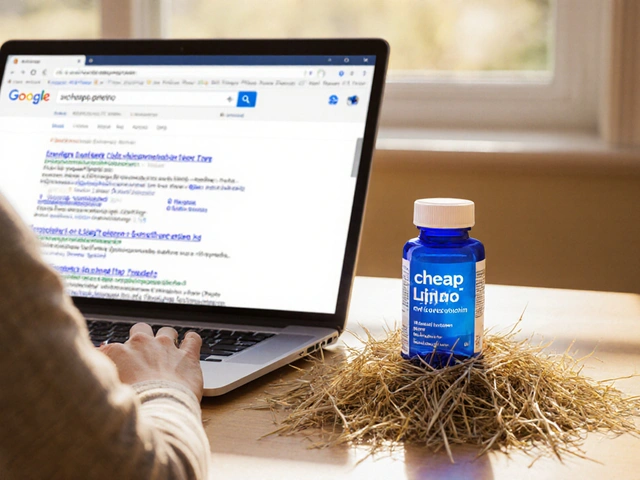Ulcerative Colitis Meal Plan Guide: Easy Steps & Sample Recipes

Ulcerative Colitis Meal Plan Calculator
Personalize Your Meal Plan
This tool helps you create a meal plan that fits your specific needs and preferences for ulcerative colitis management.
When a flare of Ulcerative colitis is keeping you away from favorite foods, the goal isn’t to starve yourself-it’s to build a ulcerative colitis meal plan that eases symptoms while still tasting good. Below you’ll find a step‑by‑step roadmap, a ready‑to‑use week of dishes, and a handful of tricks that keep the diet flexible enough for real life.
Why diet matters for Ulcerative colitis
Research from the American Journal of Gastroenterology shows that specific food choices can either trigger inflammation or help calm it. The colon’s lining is already inflamed; high‑fiber or highly fermentable foods can increase stool bulk and gas, worsening pain and urgency. On the flip side, nutrient‑dense, low‑residue options provide the vitamins and calories you need without overloading the gut.
In practice, patients report that adjusting their plate often leads to fewer emergency visits and a smoother transition back to maintenance medication. The diet isn’t a cure, but it’s a powerful adjunct that works hand‑in‑hand with pharmacology.
Core principles of an ulcerative colitis‑friendly meal plan
Before you start picking recipes, understand the building blocks that keep the gut calm.
- Low‑residue diet is a dietary approach that limits high‑fiber foods to reduce stool bulk during ulcerative colitis flare‑ups. Think white rice, peeled potatoes, and well‑cooked carrots.
- Anti‑inflammatory foods are items rich in omega‑3 fatty acids, antioxidants, and phytonutrients that help lower gut inflammation. Salmon, chia seeds, and turmeric fall in this group.
- Probiotic yogurt is a cultured dairy product that delivers live bacteria to help restore gut flora. Choose plain, low‑sugar versions.
- Omega‑3 fatty acids are essential fats found in fatty fish and flaxseed that modulate the immune response. Aim for two servings of fish per week.
- Fiber is a plant component that adds bulk to stool; during flare‑ups, stick to soluble sources like oatmeal rather than insoluble wheat bran.
- Hydration is critical for preventing dehydration caused by diarrhea and for supporting nutrient transport. Aim for at least 2‑3 liters of fluid daily.
- Vitamin D is a fat‑soluble vitamin that influences immune regulation; low levels are common in UC patients. Sun exposure and fortified foods help meet needs.
- FODMAP is a collection of short‑chain carbs that can ferment in the gut, often worsening gas and bloating. A low‑FODMAP trial can pinpoint triggers.
| Category | Typical Examples | Fiber (g per serving) | Best for Flare‑ups? |
|---|---|---|---|
| Low‑residue | White rice, peeled potatoes, canned carrots, well‑cooked eggs | 0.5‑2 | Yes |
| High‑fiber | Whole wheat bread, raw broccoli, beans, nuts | 5‑10 | No (unless in remission) |
Step‑by‑step guide to building your plan
- Identify personal triggers. Keep a simple food diary for two weeks. Note every meal, symptom severity, and stool frequency. After the period, flag foods that consistently precede pain.
- Set calorie and protein targets. Most adults need 25‑30 kcal/kg body weight per day, with 1.2‑1.5 g protein/kg to protect muscle while healing.
- Choose a base of low‑residue carbs. Aim for 3‑4 servings per day of white rice, pasta, or well‑cooked potatoes. This provides energy without excess bulk.
- Add anti‑inflammatory proteins and fats. Incorporate salmon, sardines, or tofu at each main meal. Sprinkle chia or flax seeds on oatmeal or smoothies for omega‑3 boost.
- Include probiotic sources. A ½‑cup of plain probiotic yogurt or a kefir drink each morning can help re‑balance gut flora.
- Mind the micronutrients. Vitamin D, calcium, and iron are often depleted during flare‑ups. Use fortified milk alternatives, leafy greens cooked until soft, and lean red meat in moderation.
- Plan fluids. Sip water, herbal teas, and oral rehydration solutions throughout the day. Avoid caffeine and carbonated drinks that can irritate the colon.
- Build a weekly template. Draft a simple spreadsheet: breakfast, lunch, dinner, snacks. Fill each slot with the foods from steps 3‑6. Keep the list short-variation is fine, but consistency helps the gut adapt.
By the end of this process you’ll have a concrete menu that respects your calorie needs, minimizes residue, and packs anti‑inflammatory power.

Sample 7‑day ulcerative colitis‑friendly meal plan
Feel free to swap proteins or sides based on personal preference, but keep the overall structure (low‑residue carbs + anti‑inflammatory fats) intact.
| Day | Breakfast | Lunch | Dinner | Snack |
|---|---|---|---|---|
| Monday | Oatmeal (cooked, not instant) with a spoon of chia, sliced banana, and a cup of probiotic yogurt | Grilled chicken breast, white rice, steamed carrots | Baked salmon, mashed potatoes (no skin), sautéed zucchini | Rice cakes with almond butter |
| Tuesday | Scrambled eggs, white toast, ½ cup of peeled applesauce | Turkey meatballs, quinoa (well‑rinsed), pureed pumpkin | Pan‑seared cod, couscous, boiled green beans | Plain kefir |
| Wednesday | Rice porridge with a dash of cinnamon, soft tofu cubes, probiotic yogurt | Grilled shrimp, baked sweet potato (peeled), spinach puree | Chicken stew with carrots and potatoes, served over white rice | Banana smoothie (banana, lactose‑free milk, flaxseed) |
| Thursday | Plain cottage cheese, pear slices, a drizzle of honey | Beef mince with low‑FODMAP herbs, polenta, roasted zucchini | Grilled trout, boiled potatoes, sautéed bok choy | Rice crackers with hummus (smooth, low‑garlic) |
| Friday | Protein shake (whey, lactose‑free milk, banana) | Chicken Caesar salad (no croutons, light dressing), white rice on side | Turkey breast, mashed cauliflower, boiled carrots | Plain yogurt with a spoon of ground flax |
| Saturday | Pancakes made with rice flour, topped with cooked berries (no raw) | Grilled salmon, quinoa (well‑cooked), steamed asparagus | Lean pork tenderloin, baked white potatoes, green peas (well‑cooked) | Apple sauce with cinnamon |
| Sunday | French‑toast (white bread), maple syrup, probiotic yogurt | Vegetable soup (carrots, parsnips, peeled potatoes), white rice on the side | Roasted chicken thighs, couscous, sautéed zucchini | Almond milk latte (no added sugar) |
Tips for dining out and staying flexible
- Ask for modifications. Most restaurants will swap a side of fries for a plain baked potato or remove crusty bread.
- Choose grilled or baked proteins. Avoid breaded or fried items that add unnecessary residue.
- Bring your own probiotic snack. A small container of plain Greek yogurt can rescue a meal when options are limited.
- Hydrate before, during, and after. Alcohol can exacerbate dehydration, so limit intake and follow up with water.

Common pitfalls and how to avoid them
Pitfall 1: Over‑relying on “low‑residue” as a permanent label. The diet is most useful during flare‑ups. Once symptoms ease, gradually re‑introduce soluble fiber to support gut health.
Pitfall 2: Ignoring micronutrient gaps. Frequent blood tests for iron, B12, and vitamin D help you adjust supplements before deficiencies become serious.
Pitfall 3: Skipping meals. Even on a low‑residue plan, regular meals keep blood sugar stable and prevent bingeing on high‑fat foods later.
Pitfall 4: Forgetting to track symptoms. A simple 1‑5 pain scale logged in a phone note can reveal patterns you’d otherwise miss.
Resources and tools
- MyFitnessPal - track calories, macronutrients, and fiber intake. \n
- Monash University Low‑FODMAP App - identify high‑FODMAP foods quickly.
- American College of Gastroenterology guidelines (2024) - evidence‑based recommendations for nutrition in IBD.
- Local dietitian specializing in IBD - personalized plan and follow‑up.
Can I eat whole grains while on a ulcerative colitis diet?
During a flare, whole grains are usually too high in insoluble fiber and can worsen diarrhea. Stick to white rice, refined pasta, or well‑cooked oatmeal. In remission, you can re‑introduce small portions of oats or brown rice to test tolerance.
Is probiotic yogurt safe for everyone with ulcerative colitis?
Most patients benefit from the live cultures, but if you’re lactose intolerant, choose lactose‑free probiotic drinks. Always start with a small serving to see how your gut reacts.
How much water should I drink each day?
Aim for 2‑3 liters (about 8‑12 cups) of fluid daily, more if you have watery stools. Include water, herbal teas, and oral rehydration solutions-avoid sugary sodas.
Can I use supplements like omega‑3 capsules?
Yes, omega‑3 supplements are a convenient way to hit anti‑inflammatory targets, especially if you don’t eat fish regularly. Check dosage (usually 1‑2 g EPA/DHA per day) and discuss with your doctor.
What’s the best way to re‑introduce fiber after a flare?
Start with low‑residue, soluble fiber like oatmeal or peeled apples. Add a new high‑fiber food every 3‑4 days and monitor symptoms. Gradual re‑introduction helps your gut adapt without shocking it.






Catherine Viola
October 19, 2025 AT 12:00It is evident that the prevailing nutritional guidelines are heavily influenced by pharmaceutical conglomerates seeking to sustain a market for their anti‑inflammatory drugs. Consequently, the “low‑residue” recommendation often serves as a stop‑gap rather than a genuine therapeutic approach. A rigorous analysis of the cited studies reveals hidden funding sources that bias the outcomes toward drug dependence. Patients would be better served by scrutinising the primary literature before accepting such diet plans.
Ben Bathgate
November 1, 2025 AT 13:26Wow, you actually think that plain oatmeal is the holy grail for UC? That’s rookie level advice. Most folks on the forum just melt butter in their rice and call it a day. Stop buying into the hype and get real.
Kevin Sheehan
November 14, 2025 AT 15:53Listen, the very premise of “diet fixes everything” is a reductionist myth that ignores the complex interplay of microbiota, immune signaling, and existential stress. By simplifying the disease to mere “food triggers,” we surrender agency to a commercial narrative. It is a philosophical surrender that perpetuates suffering. If you truly seek emancipation from flare‑ups, you must confront the systemic forces shaping your gut, not just swap rice for quinoa.
Penny Reeves
November 27, 2025 AT 18:20The sample meal plan does a decent job of balancing macronutrients, but it overlooks the psychosocial aspect of eating during a flare. For many patients, the fear of triggering symptoms leads to anxiety around food, which can itself exacerbate inflammation. Incorporating mindful eating practices alongside the suggested dishes could mitigate that stress. Also, rotating protein sources more frequently would prevent monotony. Remember, consistency is key, but flexibility keeps morale high.
Sunil Yathakula
December 10, 2025 AT 20:46i totally get u feelin anoyed when the plan seems boring but trust me try add some spice like ginger or turmeric it won't mess ur gut and it adds flavor
just keep it mild and watch how ur body reacts ok? stay positive!
sravya rudraraju
December 23, 2025 AT 23:13When constructing a dietary regimen for ulcerative colitis, one must first acknowledge the fundamental principle that the gastrointestinal tract operates as an integrated ecosystem, wherein each nutrient influences not only the mucosal lining but also the resident microbiota and the systemic immune response. The initial step involves a meticulous inventory of personal symptom patterns, which can be captured through a simple daily log that records meal composition, portion size, and any subsequent discomfort, thereby establishing a data set from which correlations may be drawn. Subsequently, the caloric baseline should be calculated based on basal metabolic rate and activity level, ensuring that the patient achieves a modest caloric surplus or deficit that aligns with weight goals while preserving lean muscle mass. Protein intake, often underestimated, ought to be distributed evenly across meals, targeting a minimum of 1.3 grams per kilogram of body weight, which supports mucosal repair during periods of heightened inflammation. Low‑residue carbohydrates such as refined white rice, peeled potatoes, and well‑cooked pasta provide the requisite energy substrate without imposing excessive bulk, thereby mitigating the risk of diarrhea. In parallel, the inclusion of anti‑inflammatory fats-particularly those rich in eicosapentaenoic acid (EPA) and docosahexaenoic acid (DHA)-should be emphasized, with fatty fish like salmon or sardines featured at least twice weekly, complemented by plant‑based sources such as chia and flaxseed which can be seamlessly incorporated into smoothies or oatmeal. Probiotic supplementation, in the form of plain yogurt or kefir, introduces beneficial bacterial strains that may outcompete pathogenic flora and foster a more balanced microbial community, yet the dosage must be titrated to avoid lactose‑related distress in sensitive individuals. Micronutrient repletion is another critical component; routine monitoring of serum vitamin D, iron, and vitamin B12 levels guides targeted supplementation, thereby preventing the insidious deficits that frequently accompany chronic intestinal inflammation. Hydration, though often overlooked, should be maintained at a minimum of three liters per day, with electrolyte‑balanced solutions deployed during active flare‑ups to counteract losses from profuse stools. Finally, the plan must incorporate a flexible framework that accommodates unforeseen dietary excursions, such as dining out or travel, by equipping the patient with strategies for modifying menu items-opting for grilled over fried preparations, requesting sauce on the side, and substituting high‑fiber accompaniments with low‑residue alternatives. By adhering to this comprehensive, evidence‑based schema, patients can achieve not only symptomatic relief but also a sustainable nutritional foundation that supports long‑term disease remission and overall well‑being.